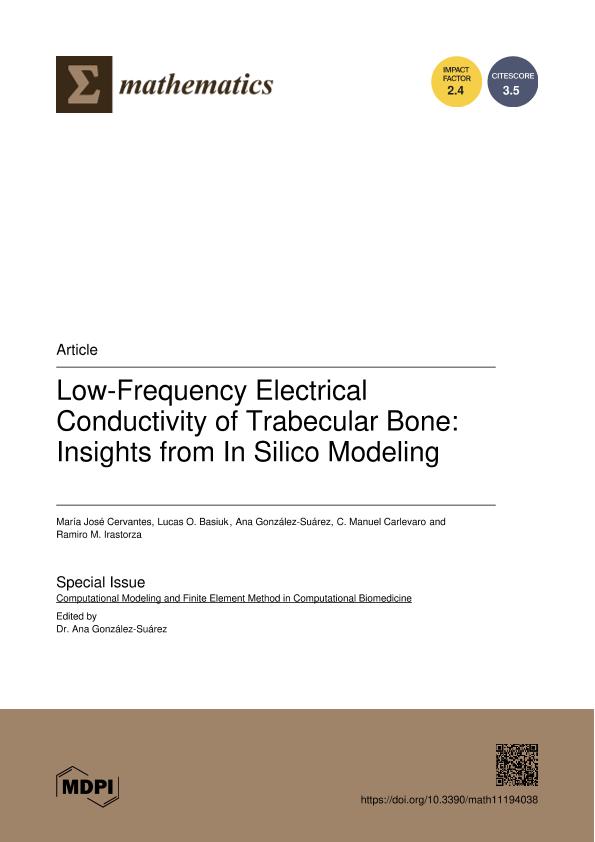Artículo
Low-Frequency Electrical Conductivity of Trabecular Bone: Insights from In Silico Modeling
Cervantes, Maria Jose ; Basiuk, Lucas Osvaldo
; Basiuk, Lucas Osvaldo ; González Suárez, Ana; Carlevaro, Carlos Manuel
; González Suárez, Ana; Carlevaro, Carlos Manuel ; Irastorza, Ramiro Miguel
; Irastorza, Ramiro Miguel
 ; Basiuk, Lucas Osvaldo
; Basiuk, Lucas Osvaldo ; González Suárez, Ana; Carlevaro, Carlos Manuel
; González Suárez, Ana; Carlevaro, Carlos Manuel ; Irastorza, Ramiro Miguel
; Irastorza, Ramiro Miguel
Fecha de publicación:
09/2023
Editorial:
MDPI
Revista:
Mathematics
ISSN:
2227-7390
Idioma:
Inglés
Tipo de recurso:
Artículo publicado
Clasificación temática:
Resumen
Background: The electrical conductivity of trabecular bone at 100 kHz has recently been reported as a good predictor of bone volume fraction. However, quantifying its relationship with free water (or physiological solution) content and the conductivities of its constituents is still difficult. Methods: In this contribution, in silico models inspired by microCT images of trabecular bovine samples were used to build realistic geometries. The finite element method was applied to solve the electrical problem and to robustly fit the conductivity of the constituents to the literature data. The obtained effective electrical conductivity was compared with the Bruggeman three-medium mixture model using a physiological solution, bone marrow and a bone matrix. Results: The values for the physiological solution plus bone marrow (together as one material) and the bone matrix that best captured the bone volume fraction in the two-medium finite element model were + = 298.4 mS/m and = 21.0 mS/m, respectively. Additionally, relatively good results were obtained with the three-medium Bruggeman mixture model, with = 103 mS/m, = 21.0 mS/m and = 1200 mS/m. Simple linear relationships between the proportions of constituents depending on bone volume fraction were tested. Degree of anisotropy and fractal dimension do not show detectable changes in effective conductivity. Conclusions: These results provided some useful findings for simulation purposes. First, a higher value for the electrical conductivity of bone marrow has to be used in order to obtain similar values to those of experimental published data. Second, anisotropy is not detectable with conductivity measurements for small trabecular samples (5 mm cube). Finally, the simulations presented here showed relatively good fitting of the Bruggeman mixture model, which would potentially account for the free water content and could rescale the model for whole-bone electrical simulations.
Palabras clave:
Computer model
,
trabecular bone
,
Electrical conductivity
Archivos asociados
Licencia
Identificadores
Colecciones
Articulos(IFLYSIB)
Articulos de INST.FISICA DE LIQUIDOS Y SIST.BIOLOGICOS (I)
Articulos de INST.FISICA DE LIQUIDOS Y SIST.BIOLOGICOS (I)
Citación
Cervantes, Maria Jose; Basiuk, Lucas Osvaldo; González Suárez, Ana; Carlevaro, Carlos Manuel; Irastorza, Ramiro Miguel; Low-Frequency Electrical Conductivity of Trabecular Bone: Insights from In Silico Modeling; MDPI; Mathematics; 11; 19; 9-2023; 1-14
Compartir
Altmétricas



